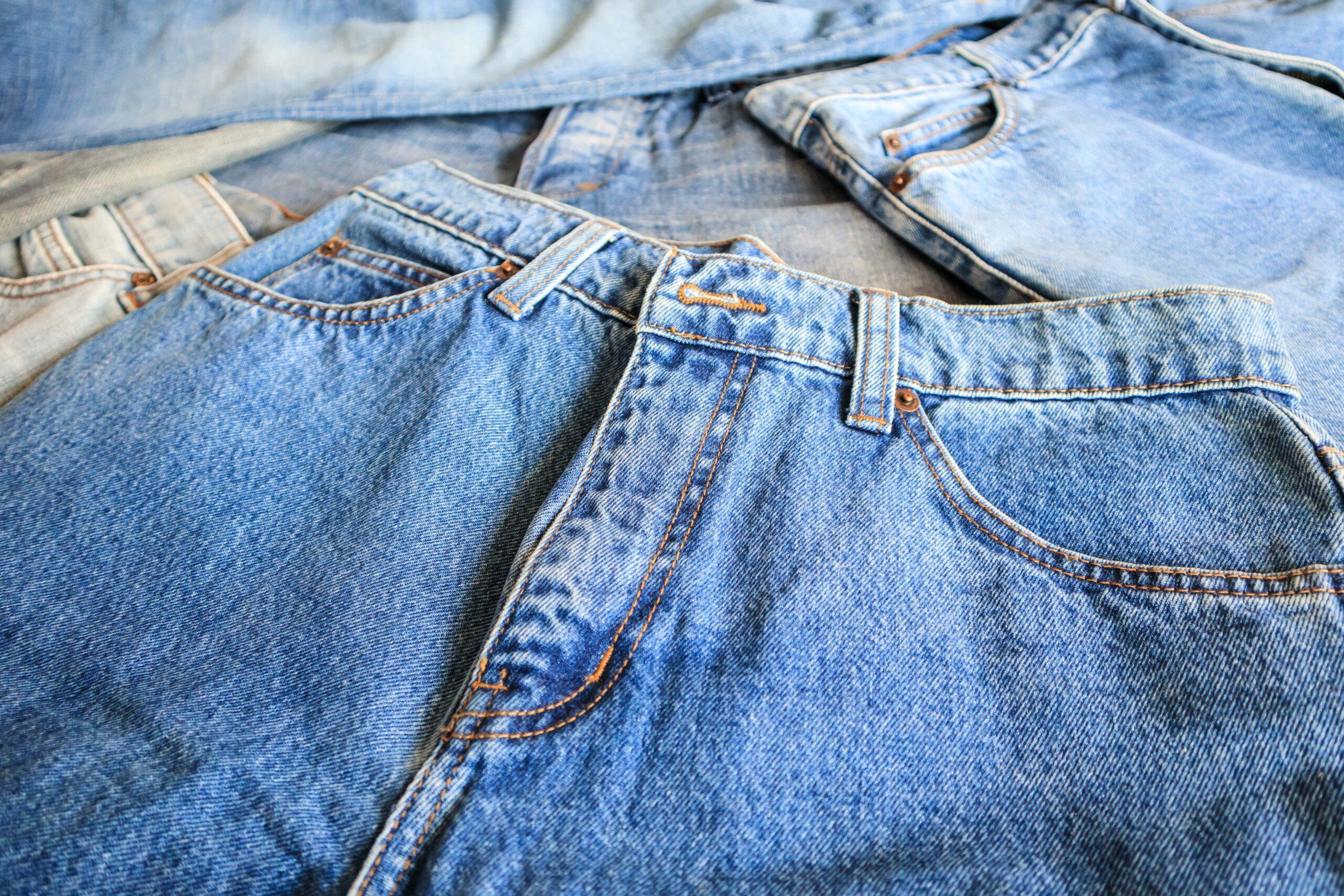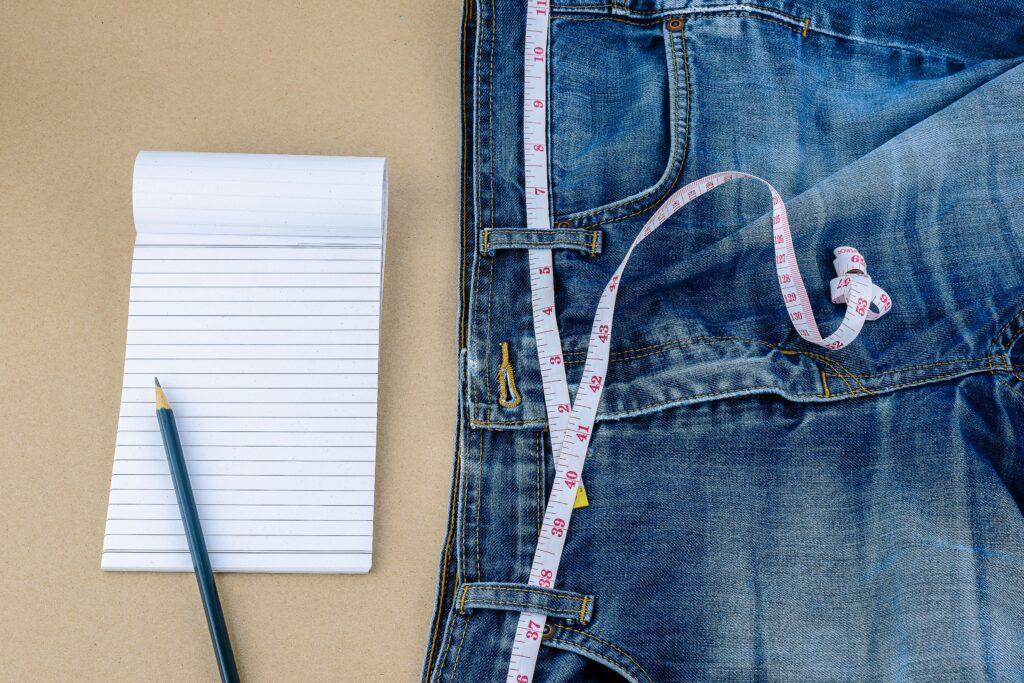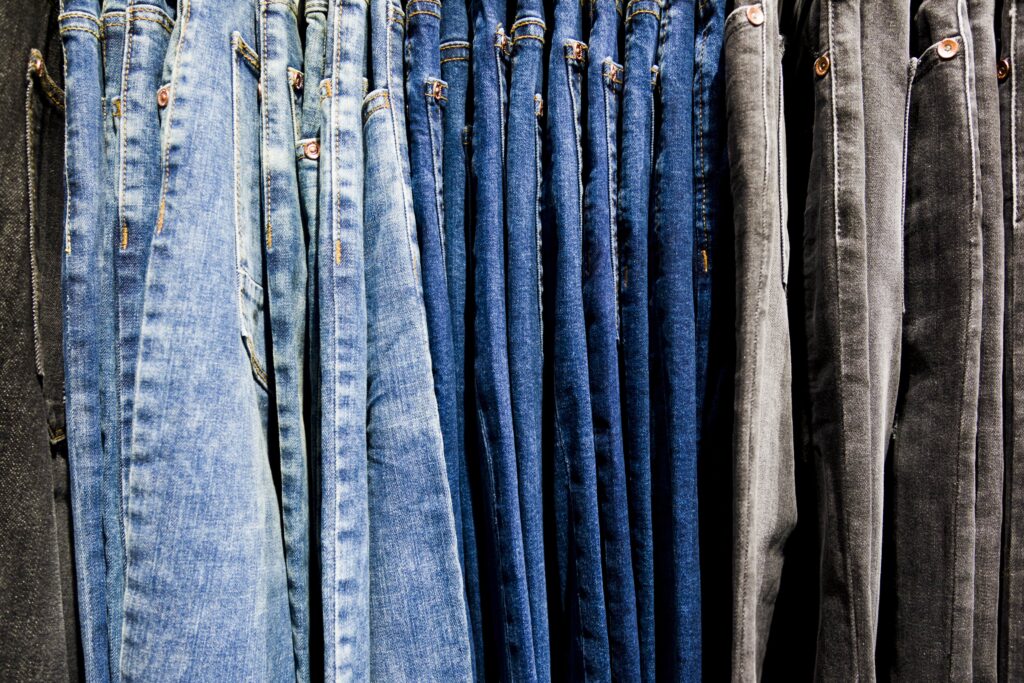Get ready to discover everything you need to know about what size women’s jeans is a 30 and say goodbye to guesswork. Get fabulous-fitting denim that will make you feel like a million bucks!
Let’s face it, finding the perfect denim pants sizes that hug your curves just right is crucial. The wrong size waist measurement can leave you feeling uncomfortable and self-conscious all day long.
So, what does a size 30 waist width actually mean? Is it too small or too big? Well, buckle up because we’re about to spill the beans. We’re here to unravel the mystery behind size 30 waist width in women’s jeans and put an end to your denim dilemmas.
With our international sizing guide, you’ll have all the information you need to find the perfect fit.
Average Jeans Sizes for Women and Men in the US:
Discovering the typical international sizing worn by women and men in America, including waist width in inches and the corresponding US sizes.
Both women and men have their own unique measurements that determine the perfect fit of pants. Understanding the average international sizing for jeans waistbands in inches can help individuals make informed choices when shopping for new denim. Let’s delve into the typical size ranges worn by women and men for pants in the US.
Highlighting the differences between women’s and men’s jeans sizes
Women’s denim pants sizes differ significantly from men’s due to variations in body shapes. While women generally have curvier figures, men tend to have straighter silhouettes. Consequently, there are distinct sizing conventions for each gender, including variations in width and inches.
For women, denim pants sizes often range from small (S) to extra-large (XL), with corresponding numerical values such as 2, 4, 6, or 8. There are size options like petite and plus-size that cater to different body types and leg lengths. The UK uses a similar sizing system as the US, while European countries follow their own standard measurements for inches.
In contrast, men’s jeans sizes typically follow waist measurements represented by numbers such as 30, 32, or 34 inches. These numbers correspond to waist circumference rather than dress size. Men’s pants also come in various lengths denoted by inseam measurements like short (S), regular (R), or long (L). The EU sizing system differs slightly but is still based on waist measurements.
Gaining insights into popular size ranges for both genders
Understanding international sizing for pants, especially in inches, can be helpful when searching for a perfect fit. In recent years, mid-range sizes have become increasingly popular among women in the US due to changing fashion trends favoring comfort over tight-fitting garments. Sizes like 6 and 8 are often sought after as they provide a balance between style and ease of movement.
For international sizing, men’s pants with waist measurements around 32 to 34 inches are frequently preferred. These sizes cater to the average build of many men in the US, offering a comfortable fit without being too loose or tight.
In addition to these popular size ranges for pants, it is important to note that the preferences and body shapes of US women differ. Some individuals may feel more comfortable in smaller or larger sizes depending on their personal style and physique.
Understanding Waist Sizes in Inches for Women’s Jeans:
Understanding waist sizes for us women is crucial when it comes to finding the right fit in pants. The right fit can make all the difference in how comfortable and confident you feel.
Breaking down waist measurements for women’s jeans
To determine what size women’s jeans is a 30, it’s essential to understand waist measurements. The waist size refers to the circumference of your natural waistline, which is typically located just above your belly button. It plays a significant role in determining the fit of your pants.
When shopping for pants, us women will often come across terms like “waist width,” “waist circumference,” or simply “waist.” These terms all refer to the measurement around our midsection.
However, it’s important to note that different brands may have slight variations in their sizing charts. Therefore, it’s always advisable for us women to consult each brand’s specific size guide before making a purchase.
Explaining how waist sizes are determined in inches
Women’s jeans, also known as pants, typically come with numeric sizing that corresponds to inches. For example, if you see a label stating “size 30,” it means that the waistband of the pants measures 30 inches in circumference.
To determine if a pair of pants with a 30-inch waist size is comfortable for you, measure your own natural waist using a measuring tape. Wrap the tape around your midsection at the desired waistband position for your pants. Be sure to avoid pulling too tight or leaving any slack when taking this measurement.
Providing clarity on how waist size affects overall fit
Understanding how different waist sizes of women’s pants affect the overall fit is essential when selecting jeans in the US. A smaller or larger than ideal size of pants can result in discomfort or an unflattering appearance.
If you are a US woman with a 30-inch waist, you can generally wear pants labeled as size 30. However, keep in mind that factors such as body shape, rise, and fabric stretch can also affect the fit.
To ensure a proper fit for us women, consider your hip measurement as well. If your hips are significantly larger than your waist, you might need to choose a different pants size or opt for jeans with some stretch.
Pay attention to the specific cut and style of the jeans you’re considering, as different fits may have varying measurements around the waist.
Remember that pants sizes can vary between brands and even within different styles from the same brand. It’s always helpful to try on multiple pairs of pants or consult customer reviews to get an idea of how a particular brand’s pants sizing runs.
Converting Men’s to Women’s Jeans Sizes with a Size Chart
Converting men’s jeans sizes to women’s pants can be a confusing and frustrating process. With different sizing systems and variations across brands, it can be challenging to find the perfect fit.
However, by using a pants size chart, you can simplify this task and accurately match up men’s sizes to their equivalent women’s pant sizes.
Simplifying the Process with a Size Chart
A pants size chart is an invaluable tool for us. It provides a visual representation of the different size categories for pants and allows us to easily identify corresponding measurements. By referring to the chart, we can quickly determine the appropriate women’s pants size based on our knowledge of men’s sizes.
To effectively use a jeans size chart for men’s pants, start by identifying your current men’s jean size. This will be your starting point for conversion.
Locate this size on the chart and follow the row horizontally until you find the corresponding women’s jean size column. The intersection of these two points will give you an accurate conversion for pants.
Matching Up Different Sizing Systems Accurately
One of the challenges in converting men’s jeans sizes to women’s in the US is dealing with international sizing variations and different measurement systems. A reliable jeans size chart takes these factors into account, ensuring accurate conversions regardless of where the jeans were manufactured.
When using a jeans size chart for conversion, pay attention to any notes or instructions provided alongside it. These additional details may highlight specific brand variations or offer insights into how certain measurements should be interpreted.
By following these guidelines, you can ensure that your conversions are as precise as possible.
Finding Equivalent Women’s Jean Sizes Based on Men’s Sizes
The main advantage of using a jeans size chart is that it makes finding equivalent women’s jean sizes based on men’s sizes much easier. Instead of guessing or relying on trial and error, the chart provides a clear roadmap for conversion. This saves you time and frustration, allowing you to quickly identify the right women’s jean size that corresponds to your preferred men’s size.
Here’s an example of how a jeans size chart can simplify the process for us women.
- Men’s Jeans Size: 30
- Locate “30” on the men’s jean size row of the chart for us women.
- Follow this row horizontally until you reach the women’s jean size column in the US.
- The intersection will reveal the equivalent women’s jean size for us, which might be something like “8.”
By using a jeans size chart, you can confidently convert men’s jeans sizes to women’s without second-guessing or confusion.
Determining the Right Length (Inseam) for Women’s and Men’s Jeans:
Understanding inseam measurements and their significance in jean fitting
One crucial factor for us women to consider is the inseam size. The inseam, which refers to the length of the inner seam of a pair of pants, is essential for ensuring that your jeans fit and flatter your body shape.
Differentiating between inseam lengths for women and men
Inseam lengths can vary between women’s and men’s jeans. Women’s jeans typically come in various length options such as petite, regular, and tall, catering to different heights. On the other hand, men’s jeans generally have a standard inseam length that can be altered if necessary. It is helpful to refer to a pants size chart to determine the appropriate waist size for both men and women.
Helping US women determine their ideal inseam length based on height or preference using the pants size chart and waist size.
Finding the right inseam length for us women depends on your height or personal preference. Here are some tips to help you determine your ideal inseam size.
- Measure Yourself: To get an accurate measurement for your pants size, stand straight with your feet shoulder-width apart. Use a measuring tape to measure from your crotch down to where you want your jeans to end—either at the ankle bone or slightly longer if you prefer a stacked look. This will help you determine your waist size using the pants size chart.
- Consider Your Leg Length and Pants Size: Take into account whether you have long legs or shorter legs compared to your overall height. If you have longer legs, you might need a longer inseam length than someone with shorter legs. This is important when determining your waist size for pants.
- Try Different Cuts: Different jean cuts may affect how the inseam fits on US women’s bodies, especially depending on their waist size. For example, skinny jeans tend to have a longer appearance due to their tapered leg design, while bootcut or flare jeans may require a slightly longer inseam for proper coverage.
- Check Sizing Charts: Many clothing brands provide sizing charts that correlate inseam measurements with specific sizes. Refer to these charts to find the inseam length that corresponds to your waist size.
- Consider seeking tailoring options for jeans with a longer inseam length than desired. Taking them to a tailor can ensure a custom fit, especially for those with a specific waist size.
Finding the right size women’s jeans with a 30-inch inseam is possible by following these guidelines. Remember, each brand may have slight variations in their sizing, so it’s always helpful to try on different styles and consult their specific size charts.
Impact of Different Cuts and Fits on Women’s Jeans Sizing:
Understanding how different cuts and fits can impact waist size is crucial. From skinny to bootcut, each style has its own unique characteristics that can affect how the jeans fit and feel on your waist. Let’s dive into the world of women’s jeans sizing and explore the impact of various cuts and fits on waist size.
Examining how various cuts and fits affect overall jean sizing
The cut and fit of a pair of jeans play a significant role in determining their overall size. While waist measurements are typically used as a standard guide, different cuts may require adjustments in size selection.
For instance, skinny jeans tend to have a tighter fit throughout the leg, hugging every curve. This means that even if you usually wear a size 30 in straight or bootcut jeans, you might need to go up a size or two when opting for skinny jeans.
On the other hand, straight-leg jeans offer a more relaxed fit from hip to ankle. They provide ample room for movement without compromising style. When choosing straight-leg jeans, you can generally stick to your usual size unless there are specific brand variations.
Bootcut jeans feature a fitted thigh area that gradually widens from the knee down, accommodating boots effortlessly. Their slight flare at the bottom creates an elongating effect on the legs while maintaining comfort. Similar to straight-leg jeans, sticking with your regular size is often recommended for bootcut styles.
Other popular styles like wide-leg or flared jeans bring their own unique considerations. Wide-leg jeans offer a loose-fitting silhouette throughout the leg, providing maximum comfort and freedom of movement. Flared jeans are similar but have a more pronounced flare starting from below the knee.
Discussing differences between skinny, straight, bootcut, and other styles
To better understand how different cuts impact sizing choices in women’s jeans, let’s break down the key characteristics of each style:
- Skinny jeans: These form-fitting jeans have a snug fit from waist to ankle, accentuating the curves of the legs. They are ideal for creating a sleek and trendy look.
- Straight-leg jeans: With a straight cut from hip to ankle, these jeans offer a more relaxed fit while maintaining a classic appearance.
- Bootcut jeans: Fitted through the thigh and slightly flaring out from below the knee, bootcut jeans provide balance and versatility for both casual and dressier outfits.
- Wide-leg jeans: Offering a loose fit throughout the leg, wide-leg jeans prioritize comfort and create an effortlessly chic aesthetic.
- Flared jeans: Similar to wide-leg jeans, flared jeans have a pronounced flare starting below the knee, adding a touch of retro style to any outfit.
Recognizing that different cuts may require adjustments in size selection
It is essential to recognize that different cuts and fits can vary across brands and even within specific styles. Due to variations in manufacturing processes and design preferences, it’s recommended to try on multiple sizes when shopping for women’s jeans.
To ensure you find your perfect fit, pay attention to size charts provided by manufacturers or retailers online. These charts often include detailed measurements for waist circumference, hip width, inseam length, and more.
Overcoming the Hassle of Trying on Every Size While Jeans Shopping
Are you tired of spending hours in a store, trying on multiple sizes of jeans just to find the perfect fit? It can be frustrating and time-consuming. But fear not! There are strategies and tips you can use to minimize this hassle and make your jeans shopping experience more efficient.
Estimating Your Size Before Trying On Jeans
One way to save time is by estimating your size before stepping into the fitting room. Here are some tips to help you with this:
- Know your measurements: Take a measuring tape and measure your waist, hips, and inseam. This will give you a better idea of what size you should be looking for.
- Use sizing charts: Different brands have different sizing standards, so it’s essential to check their sizing charts before making a purchase. These charts usually provide measurements for each size, allowing you to choose the one that aligns with your measurements.
- Consider your body shape: Understanding your body shape can also guide you in selecting the right size. For example, if you have wider hips, you might need a larger size even if your waist measurement suggests otherwise.
- Read reviews: Online reviews can be helpful when determining how true-to-size a particular brand or style is. Look for feedback from customers who have similar body types as yours to get an accurate sense of fit.
Strategies for Minimizing Multiple Size Try-Ons
Trying on every available size can be exhausting and time-consuming. To avoid this tedious process, consider these strategies:
- Start with known sizes: If you already own well-fitting jeans from certain brands or styles, use them as a reference point when shopping for new ones. Stick to those sizes as a starting point since they are likely to work well again.
- Utilize store associates’ expertise: Store associates are there to assist customers like yourself! Don’t hesitate to ask for their help in finding the right size. They are knowledgeable about the store’s inventory and can recommend styles that typically run larger or smaller.
- Try on multiple styles at once: Instead of trying on one pair at a time, gather several different styles in your estimated size range. This way, you can compare the fit and feel of each style without needing to go back and forth between the fitting room and the racks.
- Consider stretchy materials: Skinny jeans with stretchy fabric can be forgiving. They tend to conform to your body shape better, making it easier to find a comfortable fit.
By utilizing these strategies and tips, you can save time and energy while shopping for women’s jeans. Remember, estimating your size beforehand, understanding your body shape, and using store associates’ expertise are all helpful techniques in finding that perfect pair of jeans without having to try on every single size available.
So next time you’re browsing through the racks, keep these ideas in mind and make your jeans shopping experience more efficient than ever before!
Conclusion: Understanding “What Size Women’s Jeans is a 30”
In conclusion, determining the right size of women’s jeans can be confusing, especially when faced with the question of what size is a 30.
However, by considering average jeans sizes for both men and women in the US, understanding waist sizes in inches, converting between men’s and women’s sizes using a size chart, determining the right length (inseam), and considering different cuts and fits, you can find the perfect pair of jeans that fit you like a glove.
To make your jeans shopping experience hassle-free, it’s important to know your measurements and consult size charts provided by retailers. This will help you avoid trying on every size available and save time. Keep in mind that different brands may have slight variations in sizing, so don’t hesitate to try on multiple sizes before making a final decision.
Remember that finding the right pair of jeans is not only about getting the correct numerical size but also about finding a style that suits your body shape and personal preference. Consider trying on different cuts like skinny, straight leg, bootcut or flare to see which one flatters your figure best.
Now armed with this knowledge about women’s jeans sizing, go ahead and confidently shop for that perfect pair! Don’t be afraid to experiment with different styles and sizes until you find what fits you perfectly.
Frequently Asked Questions
Q: What if my waist measurement falls between two sizes?
A: If your waist measurement falls between two sizes on a size chart, it is generally recommended to choose the larger size for more comfort. You can always use a belt to adjust the fit if needed.
Q: How do I determine my inseam length?
A: To determine your inseam length for women’s jeans, measure from the crotch seam down to where you want the hemline of your jeans to fall. This will give you an accurate measurement for the inseam.
Q: Are women’s jeans sizes the same across all brands?
A: No, women’s jeans sizes can vary slightly between different brands. It is important to consult each brand’s size chart and try on different sizes to find the one that fits you best.
Q: Can men’s jeans be converted into women’s jeans sizes?
A: Yes, men’s jeans can be converted into women’s jeans sizes using a size chart provided by the manufacturer or retailer. Keep in mind that there may be slight variations between brands.
Q: How do I know if a particular style of jeans will flatter my body shape?
A: Experimenting with different cuts and fits is the best way to determine which style of jeans flatters your body shape. Try on various styles and see which ones accentuate your curves or create a desired silhouette.












